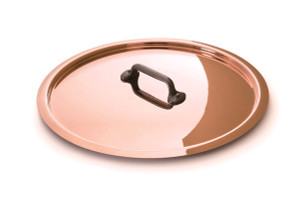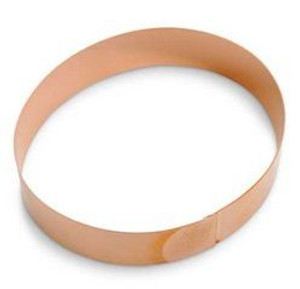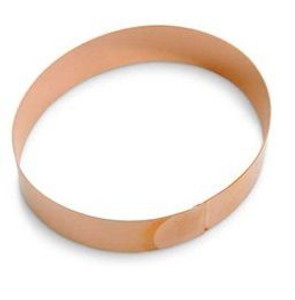
20 in. long, 16 in. wide, 4 in. deep. Includes full rack with handles. Tin lined very heavy copper.
Copper is the Choice of Professionals
Copper is the best practical conductor of heat for cooking. Professionals love it because of its quick reaction time. It cooks faster, and it also cooks better because of its uniform conductivity, as it surrounds your food with heat.
Our Mauviel copper cookware is imported from France, where it is made by hand in almost exactly the same manner as centuries ago.
The primary advantage of copper is that it requires only low to moderate heat to obtain the best results. And its conductivity makes it especially responsive to almost every cooking need. Copper has about ten times the heat conductivity of stainless and glass, and twice that of aluminum. So watch the amount of heat you give it. Let me repeat that: watch the amount of heat you give it, at least until you become accustomed to its even, fast acting conductivity.
For your first copper pan, we strongly recommend a sauce pan. There's nothing like it for performance, it's easy to use, and with a little care it will last many lifetimes.
Because it is a soft metal, a heavy gauge is more desirable for utilitarian reasons, as is hammering, which makes it stronger and able to withstand many more years of use.
Linings
Its primary disadvantage being that it is reactive to acidic foods, it is usually lined with another metal, the most common and practical of which is tin, that, unlike stainless steel or nickel, is readily refurbishable.
Stainless and nickel linings in French copper are very durable, by comparison to tin linings, and also very expensive. In general, we recommend tin for all copper pans. However, because tin melts at about 450°F we often recommend stainless for frying (and maybe saute) pans, which receive more direct heat that is not dispersed by liquids (unlike sauce pans, stock pots, etc.), thus preventing the damage that accidental overheating might cause.
Our tin lined pans are lined by hand, and will display some brush strokes as a result. Lining by hand insures thicker coats of tin, that will last much, much, much longer than pans that are electroplated.
Unlined copper works best for egg whites, which it helps to make thicker and peak longer. Zabaglione is one of the recipes most commonly made in an unlined copper pan.
Unlined copper is also widely used in the candy industry. Confectionery prepared in unlined copper doesn't react with copper, and takes advantage of the quick, high heat that the confectioner needs.
Caring for Copper
If you use wooden or other 'soft' non-scratching utensils, and watch the heat under your tin lined copper, the lining will last for years and years before it needs refurbishing.
It's not absolutely necessary that you keep the copper bright and shiny; just keep it clean. Though commercial copper cleaners work best, you can also use a paste you can make with a little flour, salt and water.
Your Health and Copper
You'll find copper listed on vitamin bottles for its benefits to our health. We have not found enough research to indicate how much copper you would have to absorb for it to be damaging to your health, but we do know that a lot of it will leach into acidic foods, causing an unpleasant taste and usually a change in coloration. That's should be good enough to discourage anyone from cooking acidic foods in copper that is not coated; the stainless, nickel and tin linings will keep the food looking and tasting the way it should.
Tin, coating the inside of many copper pans, is not reactive and we couldn't find studies that indicated it poses any health threats. Look under Stainless Steel, in our Cookware tutorial, for additional health information that relates to its primary composition of iron, chromium and nickel.
Retinning
Here's a simple method for determining if your copper pan has lost its lining. Lightly rub a bit of cleanser on a spot in the lining with a wet paper or cloth towel. If you see silver, your pan is ok. If you see copper showing through, then you might want to consider retinning.
How much shows through can help you determine whether or not to pursue retinning. If it's just scratches, and you generally don't use the pan filled with highly acidic foods, then you can wait. If you do cook highly acidic foods regularly (like making sauce with plum tomatoes) and more copper than just scratches is obvious, we recommend retinning. If you notice discoloration of food as you cook, then we also recommend retinning.
Lining on lids generally doesn't do much, as the lid doesn't come in contact with food. Still, if a lot of copper is showing, we recommend retinning.
We re-tin copper pans for in-store drop-off and pick-up, and for established customers.
Copper is the Choice of Professionals
Copper is the best practical conductor of heat for cooking. Professionals love it because of its quick reaction time. It cooks faster, and it also cooks better because of its uniform conductivity, as it surrounds your food with heat.
Our Mauviel copper cookware is imported from France, where it is made by hand in almost exactly the same manner as centuries ago.
The primary advantage of copper is that it requires only low to moderate heat to obtain the best results. And its conductivity makes it especially responsive to almost every cooking need. Copper has about ten times the heat conductivity of stainless and glass, and twice that of aluminum. So watch the amount of heat you give it. Let me repeat that: watch the amount of heat you give it, at least until you become accustomed to its even, fast acting conductivity.
For your first copper pan, we strongly recommend a sauce pan. There's nothing like it for performance, it's easy to use, and with a little care it will last many lifetimes.
Because it is a soft metal, a heavy gauge is more desirable for utilitarian reasons, as is hammering, which makes it stronger and able to withstand many more years of use.
Linings
Its primary disadvantage being that it is reactive to acidic foods, it is usually lined with another metal, the most common and practical of which is tin, that, unlike stainless steel or nickel, is readily refurbishable.
Stainless and nickel linings in French copper are very durable, by comparison to tin linings, and also very expensive. In general, we recommend tin for all copper pans. However, because tin melts at about 450°F we often recommend stainless for frying (and maybe saute) pans, which receive more direct heat that is not dispersed by liquids (unlike sauce pans, stock pots, etc.), thus preventing the damage that accidental overheating might cause.
Our tin lined pans are lined by hand, and will display some brush strokes as a result. Lining by hand insures thicker coats of tin, that will last much, much, much longer than pans that are electroplated.
Unlined copper works best for egg whites, which it helps to make thicker and peak longer. Zabaglione is one of the recipes most commonly made in an unlined copper pan.
Unlined copper is also widely used in the candy industry. Confectionery prepared in unlined copper doesn't react with copper, and takes advantage of the quick, high heat that the confectioner needs.
Caring for Copper
If you use wooden or other 'soft' non-scratching utensils, and watch the heat under your tin lined copper, the lining will last for years and years before it needs refurbishing.
It's not absolutely necessary that you keep the copper bright and shiny; just keep it clean. Though commercial copper cleaners work best, you can also use a paste you can make with a little flour, salt and water.
Your Health and Copper
You'll find copper listed on vitamin bottles for its benefits to our health. We have not found enough research to indicate how much copper you would have to absorb for it to be damaging to your health, but we do know that a lot of it will leach into acidic foods, causing an unpleasant taste and usually a change in coloration. That's should be good enough to discourage anyone from cooking acidic foods in copper that is not coated; the stainless, nickel and tin linings will keep the food looking and tasting the way it should.
Tin, coating the inside of many copper pans, is not reactive and we couldn't find studies that indicated it poses any health threats. Look under Stainless Steel, in our Cookware tutorial, for additional health information that relates to its primary composition of iron, chromium and nickel.
Retinning
Here's a simple method for determining if your copper pan has lost its lining. Lightly rub a bit of cleanser on a spot in the lining with a wet paper or cloth towel. If you see silver, your pan is ok. If you see copper showing through, then you might want to consider retinning.
How much shows through can help you determine whether or not to pursue retinning. If it's just scratches, and you generally don't use the pan filled with highly acidic foods, then you can wait. If you do cook highly acidic foods regularly (like making sauce with plum tomatoes) and more copper than just scratches is obvious, we recommend retinning. If you notice discoloration of food as you cook, then we also recommend retinning.
Lining on lids generally doesn't do much, as the lid doesn't come in contact with food. Still, if a lot of copper is showing, we recommend retinning.
We re-tin copper pans for in-store drop-off and pick-up, and for established customers.
- Country of Origin:
- Made in France
- Primary Material:
- Copper






